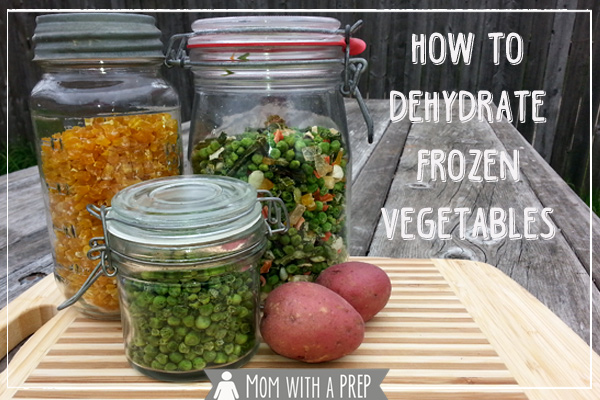
So, you have a dehydrator and you don’t have a clue about what dehydrating recipes to do with it. You ask your friends and most of them will tell you to tackle something really easy like apples or mushrooms. While those are fairly easy to dehydrate, there’s something that is so completely easy to do, it will let you clean out your freezer, and be something useful in its final dehydrated stage. It will give you a huge confidence boost that you can do this! So, here are ways to dehydrate frozen vegetables.
Tips to Dehydrate Frozen Vegetables
Vegetables that are in your grocer’s frozen food aisle are usually picked and flash-frozen immediately after the blanching process. They don’t sit in the bin for weeks waiting for some hapless soul to purchase them as fresh vegetables do. They also don’t sit in the fridge for weeks before the poor hapless soul realizes she’s purchased said vegetable and hasn’t a clue what to do with it. Also, there’s white fuzz growing on it, or weird arms and legs coming out of it like a crazy potato with alien appendages. You can go with the organic variety or not. I’m not judging either way.
Really. This is super easy to do. What is simpler than whacking a package on the counter once or twice to make sure there are no clumps, cutting it open, pouring it on your dehydrator trays, and turning the machine on? 6-10 hours later, you come away with some amazing little nuggets of vegetables that are great for just chucking into soups or stews or even grinding into alternative flour or powder.
Wait? What? Did I say alternative flour? Yep, and more on that in a minute. Let’s get through the dehydrating process first.
A Quick Tip about Dehydrating: If you can eat it raw, you generally don’t need to blanch it. If you normally eat it cooked, you need to blanch it. The easy part of doing frozen vegetables – they’ve already been blanched for you! So no need to do the big pot full of boiling water, tossing your prepared and cut up veg in for a minute, then putting them in an ice bath to stop the cooking process, etc. This is quick and easy!
How To Dehydrate Frozen Vegetables?
1. Open a pack of frozen vegetables.
2. Spread out on your dehydrator tray.
3. Set the dehydrator to 125F.
4. Begin to check at the 6-hour mark. Some frozen vegetables dehydrate more quickly than others. If you are using a bulky mix of vegetables, you might want to pull out the fully dehydrated vegetables to let the bulky ones keep going.
5. Store in an airtight container. These could either be stored in mylar bags, canning jars (either vacuum-sealed or with oxygen absorbers), or zip-top bags (this is for short-term storage only).
Tips:
- When I pulled these out, I found that I had to throw the okra back in for a little longer as it was still a little pliable. If you have larger chunks of veg, you can leave them out for a little while and cut them down before throwing them into the dehydrator, or pull everything else out and let the larger chunks go a bit longer.
- Also, if you have chunks of frozen veg that are in icy chunks, just tap your bag on the counter a few times to break those chunks up. You can also let them sit on your counter for an hour or so to melt some of that ice away and just put the veg on a linen cloth to soak up the excess moisture before pouring it onto your trays. However, some moisture won’t be a problem as it will evaporate away during the process.
What to Do with Dehydrated Frozen Vegetables?
- Throw a few handfuls in a soup or stew. This will bulk up your vegetable quotient and you don’t have to prepare anything ahead of time.
- Grind it to make a vegetable powder that you can toss into things like meatloaf, any casseroles, curries, burgers, smoothies, etc., to bulk up your vegetable intake. Much like making green kale powder. You can even add vegetable powder to sour cream or soft tofu or yogurt to create a dipping sauce.
- Use the corn to grind and make cornmeal.
Here is the dehydrator that I used, though I’ve also used another dehydrator for years and loved it. In addition, I have this Food Saver for vacuum-sealing my jars and use both the wide-mouth and regular-mouth attachments. If you’re a book person and would love to have a book in your kitchen full of awesome ways to dehydrate all kinds of foods and make meals from them, check out the Ultimate Dehydrator Cookbook.
Final Thoughts
Go ahead. Give it a try. Go to your freezer and pull out those old, lumpy frozen vegetable bags and do something with them! Even if they are a little freezer burned, it’s okay. Fresh is always best, but in this instance, in these circumstances, no one is ever going to know! And it’s SOOOOO easy! Avoid wasting your vegetables by throwing them. If they have been in your fridge for a while now, don’t worry. We can still make use of them. There is still more that we could do. Make sure to follow the step-by-step procedure on how to do it.
Mike is a preparedness enthusiast, adventurer, and sports fanatic. He followed in his family’s footsteps and undertook training and education in disaster survival, home preparedness, and personal safety. When he is not out on his next adventure, Mike offers our readers a glimpse into how and what it means to live a prepared life.
Last update on 2023-03-27 at 19:19 / Affiliate links / Images from Amazon Product Advertising API



